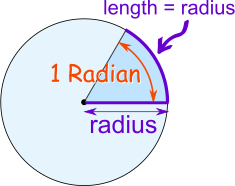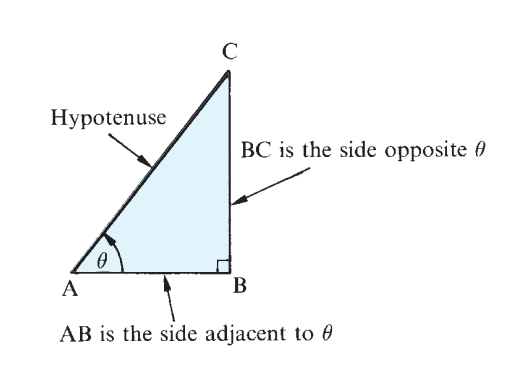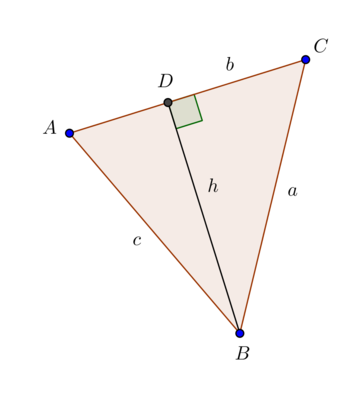Chapter 4 Introduction to Trigonometry
Reading Materials: Croft, A. and R. Davidson Foundation maths. (Harlow: Pearson, 2016) 6th edition. Chapter 22 Introduction to trigonometry.
4.1 Angles

An angle is the measure of separation between two rays that share a common starting point (vertex).
4.1.1 Units of Measurement
Degrees (°):
- 1 flat angle = 180°
- 1 complete angle = 360°
- 1° = 60 minutes (′)
- 1′ = 60 seconds (″)
Radians:

Defined using the arc of a circle:
\[\begin{equation} 1 \text{ radian} = \frac{\text{arc length}}{\text{radius}} \end{equation}\]
A complete circle = \(2\pi\) radians = 360°
Conversion formulas:
\[\begin{equation} \text{radians} = \text{degrees} \times \frac{\pi}{180}, \quad \text{degrees} = \text{radians} \times \frac{180}{\pi} \end{equation}\]
4.1.2 Type of Angles
| Type of Angle | Measure (Degrees) | Measure (Radians) | Notes |
|---|---|---|---|
| Acute angle | \(0^\circ < \theta < 90^\circ\) | \(0 < \theta < \tfrac{\pi}{2}\) | Smaller than a right angle |
| Right angle | \(\theta = 90^\circ\) | \(\theta = \tfrac{\pi}{2}\) | Quarter turn |
| Obtuse angle | \(90^\circ < \theta < 180^\circ\) | \(\tfrac{\pi}{2} < \theta < \pi\) | Between right and flat |
| Flat angle | \(\theta = 180^\circ\) | \(\theta = \pi\) | Straight line |
| Reflex angle | \(180^\circ < \theta < 360^\circ\) | \(\pi < \theta < 2\pi\) | More than flat, less than full turn |
| Complete angle | \(\theta = 360^\circ\) | \(\theta = 2\pi\) | Same as \(0^\circ\) due to periodicity |
4.2 Triangles
Definition
A triangle is a polygon with three sides and three angles.
The sum of the interior angles of a triangle is always:
\[\begin{equation} 180^\circ \; \; \text{(or } \pi \text{ radians)} \end{equation}\]
Classification by Sides
- Equilateral: 3 equal sides, 3 equal angles (each 60°).
- Isosceles: 2 equal sides, 2 equal angles.
- Scalene: no equal sides, no equal angles.
Classification by Angles
- Acute triangle: all angles < 90°.
- Right triangle: one angle = 90°.
- Obtuse triangle: one angle > 90°.
Exterior Angle Theorem
An exterior angle of a triangle equals the sum of the two opposite interior angles:
\[\begin{equation} \text{Exterior angle} = \text{Angle}_1 + \text{Angle}_2 \end{equation}\]
Triangle Inequality
For any triangle with sides \(a, b, c\):
\[\begin{equation} a + b > c, \quad b + c > a, \quad c + a > b \end{equation}\]
- The sum of the lengths of any two sides must be greater than the third side.
- This condition ensures the three sides can actually form a triangle.
Special case:
- If \(a + b = c\), the points are collinear (they lie on a straight line), so no triangle is formed.
4.2.1 Special Triangles
1. Equilateral Triangle
All sides are equal: \(a = b = c\)
All angles are equal: \(60^\circ\) each
Height formula:
\[\begin{equation} h = \frac{\sqrt{3}}{2}a \end{equation}\]
Area:
\[\begin{equation} A = \frac{\sqrt{3}}{4}a^2 \end{equation}\]
2. Isosceles Triangle
Two equal sides: \(a = b \neq c\)
Two equal base angles.
If base = \(c\), height from apex bisects base:
\[\begin{equation} h = \sqrt{a^2 - \left(\frac{c}{2}\right)^2} \end{equation}\]
3. Right Triangle
One angle = \(90^\circ\).
Sides:
- Hypotenuse = longest side (opposite right angle).
- Legs = other two sides.
Area:
\[\begin{equation} A = \frac{1}{2} \times \text{(base)} \times \text{(height)} \end{equation}\]
Foundation for Pythagoras’ Theorem (next section).
4.2.2 Similar Triangles
Definition
Two triangles are similar if they have the same shape but not necessarily the same size.
- Corresponding angles are equal.
- Corresponding sides are proportional.
Notation
\[\begin{equation} \triangle ABC \sim \triangle DEF \end{equation}\]
means \(\angle A = \angle D, \; \angle B = \angle E, \; \angle C = \angle F\) and
\[\begin{equation} \frac{AB}{DE} = \frac{BC}{EF} = \frac{CA}{FD} \end{equation}\]
Conditions for Similarity
Two triangles are similar if:
- AA (Angle-Angle): Two pairs of angles are equal.
- SSS (Side-Side-Side): Ratios of all three pairs of sides are equal.
- SAS (Side-Angle-Side): Ratios of two sides are equal and the included angle is equal.
Property
- Ratio of areas of two similar triangles equals the square of the ratio of corresponding sides:
\[\begin{equation} \frac{\text{Area}_1}{\text{Area}_2} = \left(\frac{\text{Side}_1}{\text{Side}_2}\right)^2 \end{equation}\]
4.2.3 Pythagoras’ Theorem
Statement
In a right-angled triangle:
\[\begin{equation} a^2 + b^2 = c^2 \end{equation}\]
- \(a, b\) = legs (sides adjacent to right angle)
- \(c\) = hypotenuse (side opposite the right angle, longest side)
Pythagorean Triples
Integer solutions to \(a^2 + b^2 = c^2\).
Common examples:
- (3, 4, 5)
- (5, 12, 13)
- (8, 15, 17)
Multiples also work (e.g., 6, 8, 10).
4.3 Trigonometric Relations
4.3.1 Basic Ratios (Right Triangles)

For a right triangle with:
- Angle \(\theta\)
- Opposite side = \(O\)
- Adjacent side = \(A\)
- Hypotenuse = \(H\)
\[\begin{equation} \sin \theta = \frac{O}{H}, \quad \cos \theta = \frac{A}{H}, \quad \tan \theta = \frac{O}{A} \end{equation}\]
Mnemonic: SOH-CAH-TOA
- Sine = Opposite / Hypotenuse
- Cosine = Adjacent / Hypotenuse
- Tangent = Opposite / Adjacent
4.3.2 Law of Sines
\[\begin{equation} \frac{a}{\sin A} = \frac{b}{\sin B} = \frac{c}{\sin C} \end{equation}\]
Proof:
Construct the altitude from \(B\).

From the definition of sine:
\[\begin{equation} \sin A = \frac{h}{c}, \quad \sin C = \frac{h}{a} \end{equation}\]
Thus:
\[\begin{equation} h = c \sin A, \quad h = a \sin C \end{equation}\]
This gives:
\[\begin{equation} c \sin A = a \sin C \end{equation}\]
So:
\[\begin{equation} \frac{a}{\sin A} = \frac{c}{\sin C} \end{equation}\]
Similarly, constructing the altitude from \(A\) gives:
\[\begin{equation} \frac{b}{\sin B} = \frac{c}{\sin C} \end{equation}\]
4.3.3 Law of Cosines
\[\begin{equation} c^2 = a^2 + b^2 - 2ab\cos C \end{equation}\]
Proof:
Using the same triangle from previous proof, let:
\[\begin{equation} e = \text{CD} \end{equation}\]
\[\begin{equation} f = \text{AD} \end{equation}\]
We have that △CDB and △ADB are right triangles.
Hence:
\[\begin{align} c^2 &= h^2+f^2\\ a^2 &= h^2+e^2\\ b^2 &= (e+f)^2\\ &= e^2+f^2+2ef\\ e &= A \cos C \end{align}\]
Then:
\[\begin{align} c^2 &= h^2+f^2\\ &= a^2-e^2+f^2\\ &= a^2-e^2+f^2+2e^2-2e^2+2ef-2ef\\ &= a^2+\underbrace{(e^2+f^2+2ef)}_{b^2}-2e\underbrace{(e+f)}_b\\ &= a^2 + b^2 - 2ab\cos C \end{align}\]
4.3.4 Special Angles (Summary Table)
| Angle | \(\sin \theta\) | \(\cos \theta\) | \(\tan \theta\) |
|---|---|---|---|
| \(0^\circ\) | 0 | 1 | 0 |
| \(30^\circ\) | \(\tfrac{1}{2}\) | \(\tfrac{\sqrt{3}}{2}\) | \(\tfrac{1}{\sqrt{3}}\) |
| \(45^\circ\) | \(\tfrac{1}{\sqrt{2}}\) | \(\tfrac{1}{\sqrt{2}}\) | 1 |
| \(60^\circ\) | \(\tfrac{\sqrt{3}}{2}\) | \(\tfrac{1}{2}\) | \(\sqrt{3}\) |
| \(90^\circ\) | 1 | 0 | undefined (\(\infty\)) |